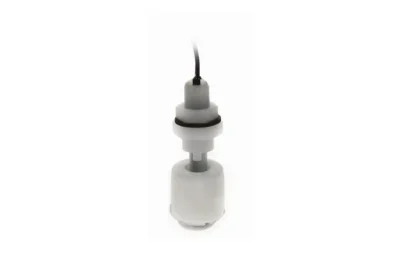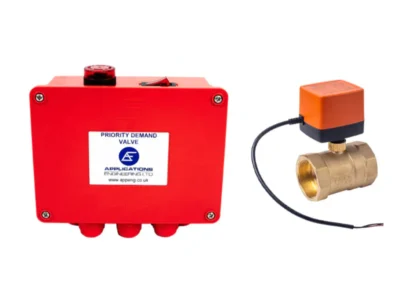A fire sprinkler flow switch detects water in the sprinkler system piping and triggers the fire alarm control panel when activated. Residential fire sprinkler systems require annual inspection and servicing under BS9251:2021, with automatic weekly testing of the pump set. If tests reveal issues, then proactive assessments of all components must be done as a priority to make the sprinkler system legally compliant.
Fire sprinkler systems must always be in pristine working condition, and they are only ever as reliable as their components. Amongst a fire protection system’s most vital and impactful products is the all-important flow switch.
For homeowners, understanding how to properly test a flow switch for a residential fire sprinkler system is more than simple maintenance etiquette and fulfilling your legal obligations. It could spell the difference between life and death for you and your family, and overlooking them can have serious consequences.
Flow switch testing in fire sprinklers forms the basis of any comprehensive maintenance and servicing programme. However, despite this, many homeowners remain unsure of the process and what constitutes a successful flow switch test.
This guide is here to break that down into simple, digestible steps so you can feel more reassured of your fire sprinkler system’s condition.
What Is a Flow Switch and Why Is It Important?
Firstly, it’s important to establish the purpose of a flow switch in a sprinkler system.
A flow switch is a device used to monitor and detect the flow rate of a liquid or gas within a fire sprinkler system. The flow switch activates when water begins moving through the sprinkler pipes, thus triggering the fire alarm system. This only typically happens when the flow reaches, exceeds, or falls below a predefined threshold, with the switch activating to trigger a particular action.
Contrary to popular belief, flow switches don’t control the water supply itself; they monitor whether water is flowing and perform a desired action which triggers the building’s fire alarm. This is why they are indispensable and essential for building protection systems.
In residential properties, the flow switch ensures that any activation of the sprinkler system is immediately detected, enabling a faster emergency response and alerting occupants to the fire situation.
Flow Switch Testing – The Drain Valve Process
The most effective method for testing a flow switch involves using the drain valve. This process simulates real-world fire conditions without triggering sprinkler heads.
Here is a breakdown of how the drain valve testing process works:
Step 1: Record the system’s resting pressure using the pressure gauge. In most residential systems, you should see readings between 2.5-4 bar, though this may vary depending on your specific system requirements.
Step 2: Open the drain valve on the valve set to discharge water into a suitable container. The duration will depend on your system size, with larger residential systems requiring longer discharge times to generate sufficient water flow.
Step 3: As water flows out through the drain valve, the pressure in the system should drop, creating a water movement that triggers the flow switch. This should, by extension, activate the pump, which should mimic exactly what happens during a real fire emergency.
Step 4: Close the drain valve and observe the pressure gauge. The system should return to its original pressure reading (2.5-4 bar or the appropriate pressure for your building height). If the pressure doesn’t fully recover, then the issue warrants an immediate and in-depth investigation.
Additional Considerations During Testing
When conducting your flow switch test, it’s essential to consider several other factors that could affect your system’s performance:
- Building use changes: Ensure that no modifications or changes to your home’s layout have affected the sprinkler system coverage or access
- Water supply adequacy: Verify that your water tank has sufficient water or that your mains connection is properly functioning
- Pressure gauge readings: Check that pressure levels are similar to those recorded during commissioning
- Automatic pump testing: Remember that your pump set should automatically test weekly, which is separate from the annual system inspection
If you identify issues with any of these elements, it’s recommended to contact a registered industry service provider immediately.
The Legal Requirements for Residential Flow Switch Testing
If your residential property is fitted with a fire sprinkler system, annual inspection and servicing is required under BS 9251:2021. All flow switches should be tested as part of this mandatory service routine. Homeowners must satisfy the guidance outlined in this standard to ensure compliance with UK fire safety regulations.
Insurance companies will heavily scrutinise fire safety maintenance records, and failing to conduct regular flow switch testing could potentially invalidate insurance coverage. This could, in turn, leave you personally liable for damages in the event of a fire.
For homeowners, the Regulatory Reform (Fire Safety) Order 2005 places the legal responsibility for fire safety on your shoulders, making proper maintenance and testing essential.
How to Tell if Your System Is Working
A properly functioning system during testing should exhibit several key traits:
- The system pump should start automatically when the drain valve opens and water flows through it.
- You should see a gradual pressure decrease as water discharges through the drain valve.
- The system should return to its original pressure range shortly after the drain valve closes.
- The flow switch should trigger the building’s fire alarm system, confirming that the link between fire suppression and detection systems is reliable.
How to Tell When It’s Not
Several indicators suggest your flow switch or broader system requires immediate attention from a qualified fire sprinkler system engineer:
- The pump doesn’t activate during testing
- The pressure doesn’t return to its original range after closing the drain valve
- Pressure readings remain consistently below the expected range for your system
- The fire alarm doesn’t activate despite the presence of adequate water
- There are visible leaks or damage to pressure gauges or drain valves
The Importance of Quality Fire Sprinkler Components from Applications Engineering
The reliability of your flow switch testing depends heavily on the quality of the system components. High-grade pressure sensors, accurate pressure gauges, and properly functioning drain valves are essential, but it doesn’t stop there.
Inferior components, from level switches to temperature sensors and solenoid valves, can undermine system integrity. It can lead to falsified or misleading readings, falsely convincing you of system stability despite the presence of clear, fixable issues.
When the time comes to replace or upgrade components, investing in industry-grade, approved and high-quality products from established suppliers like Applications Engineering becomes vital.
While understanding the testing process is valuable, homeowners should engage qualified professionals for comprehensive system testing. Professional fire safety engineers possess the expertise to identify subtle issues that might escape untrained observation and can ensure testing complies with current British Standards.
Ready to ensure your fire sprinkler system’s reliability? Applications Engineering supplies high-quality flow switches and sensors designed for demanding fire safety applications. Our ISO 9001 certified products provide the accuracy and reliability essential for effective flow switch testing. Contact our team today to discuss your fire safety component requirements.
Share This Post



